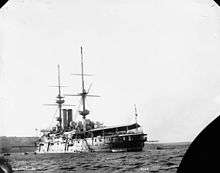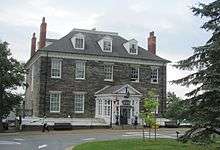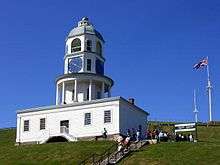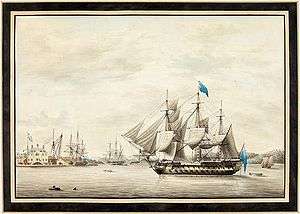Royal Naval Dockyard, Halifax
| Royal Naval Dockyard, Halifax | |
|---|---|
| Halifax, Nova Scotia | |
|
HMS Asia at the Halifax Naval Yard, 1797 | |
| Coordinates | 44°39′23.63″N 63°34′44.69″W / 44.6565639°N 63.5790806°WCoordinates: 44°39′23.63″N 63°34′44.69″W / 44.6565639°N 63.5790806°W |
| Type | Shipyard, dockyard |
| Site information | |
| Controlled by |
Royal Navy (1759–1905), |
| Official name | Halifax Dockyard National Historic Site of Canada |
| Designated | 1923 |
| Site history | |
| Built | 1759 |
| In use | 1759 – |
Royal Naval Dockyard, Halifax was a Royal Navy base in Halifax, Nova Scotia from 1759 to 1905. The Halifax Yard was the headquarters for the Royal Navy's North American Station for sixty years, starting with the Seven Years' War.
Royal Navy (1759–1905)
Halifax Harbour had served as a Royal Navy seasonal base from the founding of the city in 1749, using temporary facilities and a careening beach on Georges Island. The British purchased Gorham Point (present-day Fleet Maintenance Facility Cape Scott) for the Naval Yard, which had been named after its previous owner ranger John Gorham.[1] Land and buildings for a permanent Naval Yard were purchased in 1758 and the Yard was officially commissioned in 1759. The Yard served as the main base for the Royal Navy in North American during the Seven Years' War, the American Revolution, the French Revolutionary Wars and the War of 1812.
In 1818 Halifax became the summer base for the squadron which shifted to the Royal Naval Dockyard, Bermuda for the remainder of the year. The Halifax yard did not have a dry dock until 1887 so it was officially called the "Halifax Naval Yard" when first established, although it was popularly known as the Halifax Dockyard. The graving-dock, coaling facilities and torpedo boat slip were added between 1881 and 1897. The station closed in 1905 and sold to Canada in 1907 becoming Her Majesty's Canadian Dockyard, a function it still serves today as part of CFB Halifax.
The Yard was located on the western shores of Halifax Harbour to the north of Citadel Hill and the main Halifax townsite. In addition to refitting and supplying the North American Squadron the Halifax Yard played a vital role in supplying masts and spars for the entire Royal Navy after the loss of the timber resources in the American colonies in the American Revolution. Masts cut all over British North America were collected and stored in Halifax to be shipped to British Dockyards in wartime with heavily escorted mast convoys.
The site was designated a National Historic Site of Canada in 1923.[2]
Facilities
The building and facilities in the base included:
- careening wharf
- mast ponds and mast house
- boat house
- refitting yard
- building slip
- astronomical observatory
- commissioner's residence
- graving yard (after 1887)
- coal facility
- torpedo boat yard
- Wardroom
- victualling yard (North Dockyard)
- Gate Warder's House
- Commissioner's House
- Hospital - home to Royal Naval College of Canada from 1911 to 1917
- Admiralty House - home to the Admiral of the North American Station and now Maritime Command Museum
The Naval Yard was initially defended by its own large blockhouse, three redoubts and a fortified stone wall. These defences were enhanced and later replaced by the large network of Army fortifications whose main purposes was to safeguard the Naval Dockyard including nearby Fort Needham, Fort George, the Halifax Citadel; York Redoubt; Fort Charlotte on Georges Island, Fort Clarence in Dartmouth; five forts on McNabs Island and extensive batteries at Point Pleasant.
Ships
The main purpose of the Halifax Yard was to supply, man and refit ships but it also built some warships including:
Ships based at the Royal Navy Yard Halifax included:
- HMS Asia (1764)
- HMS Atalanta
- HMS Aeolus (1801)
- HMS Driver
- HMS Indian
- HMS Shannon (1806)
- HMS Sylph
- HMS Martin
Historic structures
Almost all the original Royal Navy 18th and 19th century buildings in the Dockyard were demolished in World War II to make way for machine shops, stores buildings and drill halls needed to man and maintain the hundreds of corvettes being commissioned during the crash expansion of the Royal Canadian Navy during the Battle of the Atlantic. Only one residence from 1814 and the Admiral's Residence from 1816 survived. The Admiral's residence in now the Maritime Command Museum. The original Naval Yard clock has been restored and moved to the Halifax Ferry Terminal entrance while the original Naval Yard bell is preserved at the Maritime Museum of the Atlantic in Halifax, a museum which also features a large diorama depicting the Naval Yard in 1813 at its height in the Age of Sail.
Gallery
 Royal Naval Dockyard, Halifax, 1804[3]
Royal Naval Dockyard, Halifax, 1804[3] HMS Renown, flagship of the North America and West Indies Station, at Halifax circa 1898.
HMS Renown, flagship of the North America and West Indies Station, at Halifax circa 1898. HMS Charybdis at the Halifax Dockyard Coaling Wharf circa 1901.
HMS Charybdis at the Halifax Dockyard Coaling Wharf circa 1901.
 Halifax Dockyard, to right of railway tracks, looking north, circa 1900. Visible are the mast house and commissioner's residence.
Halifax Dockyard, to right of railway tracks, looking north, circa 1900. Visible are the mast house and commissioner's residence.
See also
- Royal Naval Dockyard, Bermuda
- George Benson Hall
- Military history of Nova Scotia
- History of the Halifax Regional Municipality
- CFB Halifax
Endnotes
Part of a series on the |
|---|
| History of Halifax, Nova Scotia |
 |
|
History
|
|
Events
|
|
- ↑ George Bates. John Gorham 1709-1751. Collections of the Nova Scotia Historical Society, p. 87
- ↑ Halifax Dockyard. Canadian Register of Historic Places. Retrieved 9 March 2013.
- ↑ Naval Chronicle, Vol.11, p. 141
References
- Gwyn, Julian, Frigates and Foremasts: The North American Squadron in Nova Scotia Waters, 1745-1815 Vancouver, BC: UBC Press (2004) ISBN 978-0-7748-0911-5. OCLC 144078613.
- Marilyn Gurney, The Kings Yard, Maritime Command Museum, Halifax.
- Research guide B5: Royal Naval Dockyards
- CFB Halifax Officers Mess
- Brent Raymond, "Tracing the Built Form of HMC Dockyard", Nova Scotia Museum, 1999. Curatorial Report No. 88.

